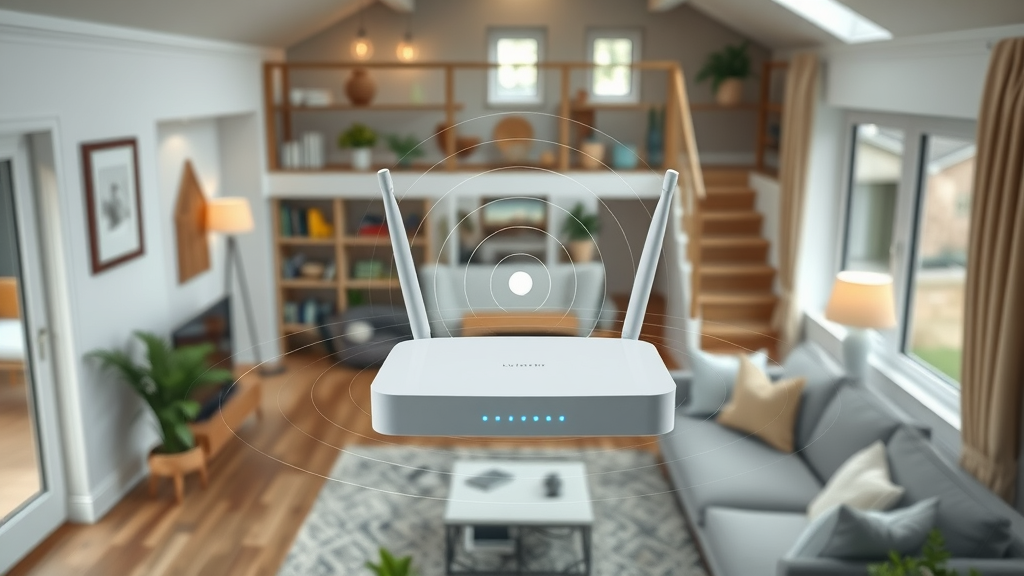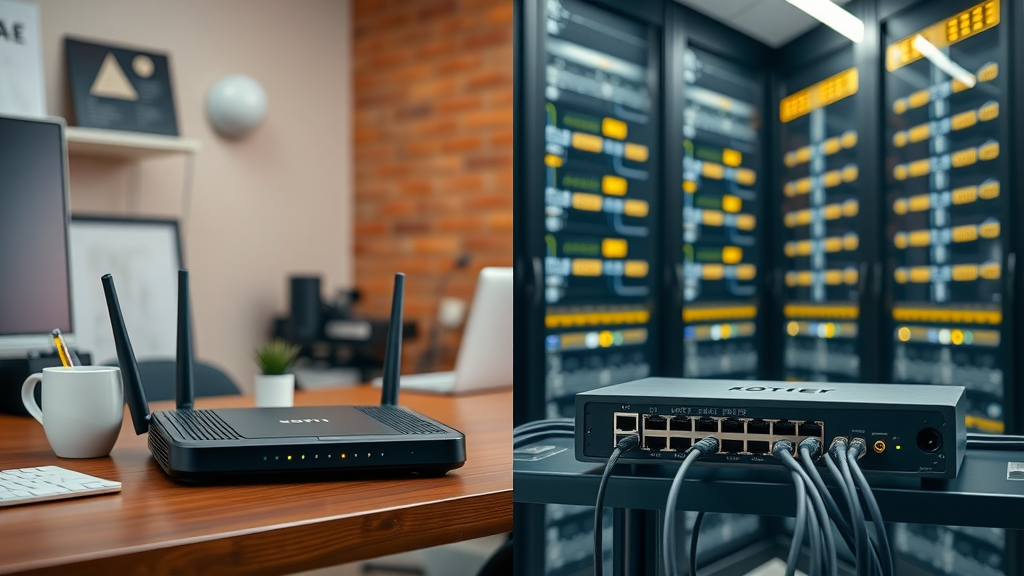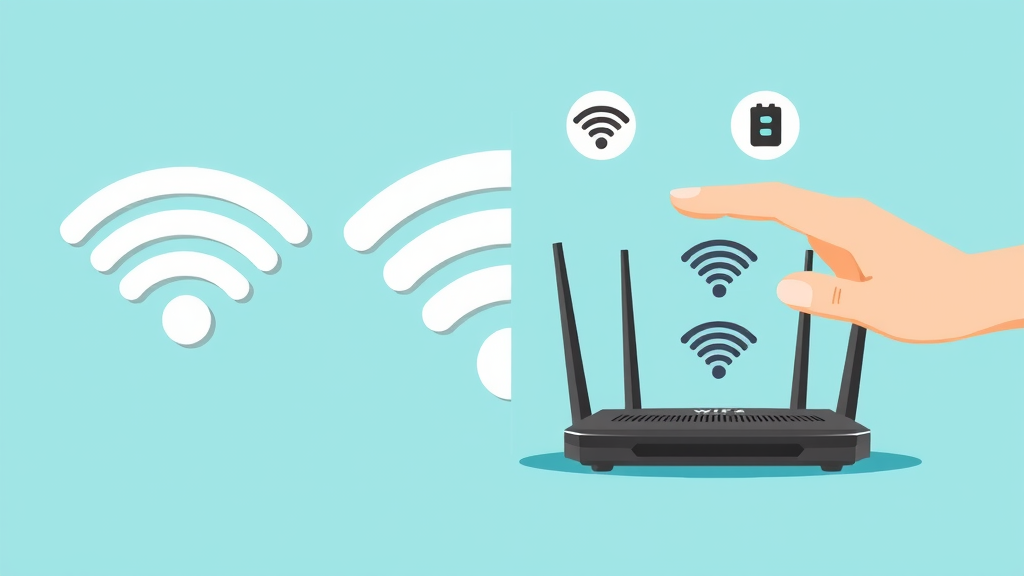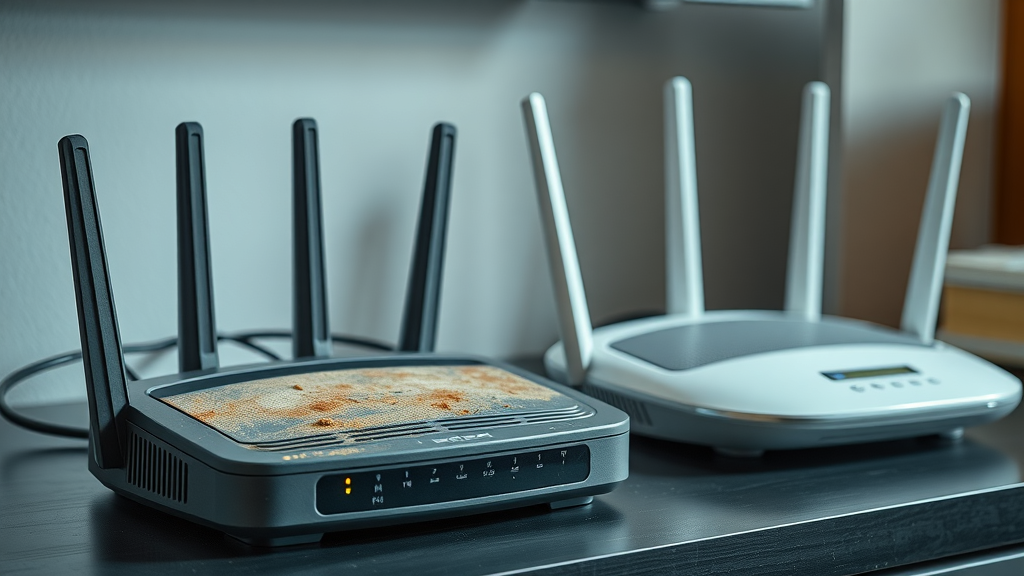Did you know? Over 40% of UK homes experience Wi-Fi dropouts weekly due to outdated router technology. If your internet’s letting you down—laggy video calls, buffering on your smart TV, or grumbling housemates—there’s a good chance your router technology is at the heart of the problem. But don’t worry: whether you’re a homeowner or a small business pro, it’s easier than you think to fix these annoyances, especially with a few simple tweaks and the right know-how!
Shocking Wi-Fi Facts: How Router Technology Impacts Everyday Life
Did you know? Over 40% of UK homes experience Wi-Fi dropouts weekly due to outdated router technology.

Let’s be honest—few things are more frustrating than slow internet when you’re banking online, working from home, or trying to watch something on your smart TV. Router technology isn’t just a “techie” concern; it’s the invisible force behind your streaming, downloads, and every FaceTime call. With so many UK homes and businesses relying on Wi-Fi, even a minor snag in your router’s performance can cause internet headaches, hitting everything from your laptop to the kids’ tablets. Understanding the root causes of these issues is the first step to a faster, more reliable internet connection.
What You'll Learn in This Guide on Router Technology
- How router technology determines Wi-Fi quality
- The difference between Wi-Fi and routers
- Troubleshooting and improving your connection
- Latest advances in home and business networking
Understanding Router Technology: The Backbone of Your Internet Connection
What is Router Technology?

Router technology is the engine that drives your entire internet connection. Think of your router as the air-traffic controller for your home’s local area network—it directs every data packet from your broadband modem to the right device and back out to the web. Whether you’re streaming, gaming, or emailing, your wireless router makes split-second decisions about where data packets go, using protocols like IP addresses. The modem connects you to the outside world, but your router manages traffic at home, ensuring your devices connect seamlessly and don’t bump into each other. In small businesses or larger homes, routers help multiple devices connect, juggle smart TVs, mobile gadgets, and even let you set up parental controls or a guest network for visitors.
Key Components: Routing Protocols, Routing Table, and Network Switch
Inside every modern wireless router lies a trio of crucial technologies. Routing protocols are like the rulebooks—they help routers decide the best path for data packets to travel. Meanwhile, the routing table acts like a detailed map, storing information on all parts of your local network and any connected device. This lets the router decide exactly where each packet should go—whether across the house to your laptop or to the printers in a small business office. Some routers also integrate a network switch, providing several Ethernet ports to connect wired devices directly for faster, more stable connections. Together, these tech building blocks are why a single wireless router can serve so many parts of your local area network at once, maintaining both speed and reliability across all your connected devices.
How Router Technology Works with Internet Protocol in a Local Area Network
Every time you tap your phone for internet access or your computer for a download, your router springs into action using internet protocol (IP) as its guiding standard. The router assigns a unique IP address to each connected device, ensuring each data packet knows exactly where to go—across your home local area network and out to the world via your broadband connection. Efficient routing protocols and a well-maintained routing table keep this system running smoothly; even one outdated element can snarl the flow, causing buffering or dropped connections. Up-to-date router technology ensures seamless communication between devices, bolstering your home or small business network with reliability and speed.
The Latest Router Technology and Innovations for Wireless Routers
What is the Latest Router Technology? A Look at Wi-Fi 6 and Beyond

The world of router technology keeps evolving—recent advances like Wi-Fi 6 and the emerging Wi-Fi 6E/7 standards are reimagining the internet at home and in the office. Wi-Fi 6 routers promise not just faster speeds, but greater reliability for multiple connected devices (think: phones, tablets, smart TVs, and security cameras working at once). Technologies like MU-MIMO (Multi-User Multiple Input Multiple Output) and OFDMA (Orthogonal Frequency Division Multiple Access) mean your router can serve many data packets at the same time. This is great for busy homes and small businesses who depend on stable internet access for video calls or streaming. Upgrading to these new standards ensures you’re not left behind as streaming quality and device requirements climb ever higher.
Smart Routing Protocols: Optimising Data Paths
Modern routers, especially those compatible with Wi-Fi 6, use smart routing protocols to work out the best, quickest paths for your data packets. If your household is teeming with tablets, laptops, and smart speakers, this technology can truly make a difference—reducing congestion and “traffic jams” on your local area network. Some routers even use automatic band steering and quality of service (QoS) settings to give priority to critical connected devices—like a smart TV during movie night or a laptop during a Zoom call—meaning your most important activities get the bandwidth they deserve. For small business owners, these innovations are lifesavers, ensuring customer-facing devices or VoIP phones never lose connection due to less important data hogs.
Mesh Wireless Router Systems vs. Traditional Models
The biggest leap forward for home and business networking? Mesh wireless router systems. Instead of relying on a single traditional router (which can leave room dead spots), mesh systems use two or more nodes to blanket your area network—even big homes or split-level businesses—with seamless wireless coverage. Each unit works together, passing data packets to and from your router’s core seamlessly. Set-up is easier than ever, and you can usually control settings (like parental control or guest networks) from a simple phone app. While traditional routers still serve many users well, mesh routers deliver vastly improved local area network reliability, especially as the number of connected devices grows.
| Feature | Traditional Routers | Mesh Wireless Router Systems |
|---|---|---|
| Coverage Area | Limited to router's range, may have dead zones | Whole-home/business coverage; seamless handoff between nodes |
| Setup | Generally simple, but complex for large spaces | Very easy, scalable with mobile apps |
| Handling Multiple Devices | May slow down with many users/devices | Handles many devices smoothly; better for busy homes/offices |
| Cost | Lower initial cost | Higher initial investment, more value for larger spaces |
| Best For | Small flats/offices, basic needs | Larger homes, small businesses with many rooms |

Types of Routers: Finding the Right Router Technology for You
The Two Main Types of Router Technology: Edge Routers vs. Core Routers

When diving into router technology, it's useful to know the difference between edge routers and core routers. Edge routers typically connect your local area network—like your home or small business—to the broader internet, sitting right at the boundary where your network meets your service provider. They handle data packets coming in and out, using routing tables and routing protocols to make quick decisions. Core routers, by contrast, are high-powered devices used by internet service providers or large enterprises, directing huge data loads across vast area networks or even globally. For nearly everyone outside major businesses, an edge router—often in the form of a wireless router—is what keeps your household or office online and connected to the world.
The Difference Between a Wi-Fi Router and a Standard Router
You may hear "router" and "Wi-Fi router" used interchangeably, but they serve slightly different purposes. A standard router directs traffic between networks, like your home and the internet, using Ethernet ports for wired connections. A Wi-Fi router takes things further by adding wireless capability, converting your broadband signal into radio waves so your devices connect wirelessly—no cables needed! Most UK homes now use wireless routers so everyone can surf from anywhere, but some small businesses (especially those needing top stability) might opt for a separate router paired with a network switch for extra reliable, wired connections on important machines. Ultimately, the right device depends on your need for flexibility, speed, and how many wired or wireless connected devices you use.
Understanding the Difference: Wi-Fi vs. Router Technology
What's the Difference Between a WiFi and a Router?

Let’s clear up the confusion: Wi-Fi and router technology are not the same thing! Wi-Fi refers to the wireless network technology that lets your devices—phones, tablets, even smart bulbs—connect to your local network without cables. The router is the physical box (often with antennas) that manages all data packets, sending them to the internet or around your home using internet protocol. Your Wi-Fi comes courtesy of your wireless router, translating your broadband internet into a signal devices can pick up using radio frequencies. While a router can sometimes function without Wi-Fi (think offices full of Ethernet cables), Wi-Fi can’t exist in your home without router technology acting as its backbone.
Wireless Router Technology in Home and Small Business Setups
Whether it’s movie night at home or your small business running a digital till, the demands on wireless router technology have never been higher. Modern routers with multiple Ethernet ports allow for wired connections—handy for gaming consoles or business-critical tills—while powerful Wi-Fi signals keep all your other devices online. With more connected devices in our lives than ever (phones, tablets, smart TVs, security cams), a robust wireless router minimises slowdowns, lets you create a secure guest network, and maintains smooth operation for everyone. Investing in quality router technology means fewer complaints about dropped Zoom calls and buffering, no matter how many devices connect at once.
Troubleshooting Wi-Fi Issues: Top Causes for Slowdowns in Router Technology
Common Router Technology Mistakes at Home
“Most users don’t realise their router’s placement can make or break the quality of service experienced at home or in a small business.”

Many Wi-Fi woes at home happen because of simple mistakes: routers placed behind TVs or stuffed in cabinets, non-stop interference from microwaves, or forgotten firmware updates. Each misstep stops your router technology from doing its best work, making your internet connection prone to slowdowns and dropouts. For homeowners and small businesses alike, regularly checking your router’s placement, updating its software, and keeping it out in the open are basic steps that prevent a world of frustration. Remember, blocked signals rarely mean strong Wi-Fi—even a modern wireless router can fail if it’s buried under books or surrounded by gadgets fighting for the same local area network bandwidth.
The Impact of Routing Table and Routing Protocol on Your Connection
Behind the scenes, your router relies on its routing table and routing protocol to navigate a maze of data packets for all your connected devices. If these tables get corrupted, or if the router’s firmware is outdated, data packets can get lost, causing dropped connections or slow internet access. Overlapping Wi-Fi channels, especially in busy UK estates or offices, mean routers can “fight” each other for the airwaves, further hampering performance. The impact? Video calls lag, smart TV streams stutter, and small businesses lose precious time waiting on downloads. Regularly checking your device, updating firmware, and reducing congestion (perhaps with a network switch or mesh system) can restore smooth and speedy operation.
- Overlapping channels
- Obsolete hardware
- Firmware updates
How to Fix Your Wi-Fi: Actionable Steps to Improve Router Technology Performance
Easy Upgrades for Wireless Router Technology
If laggy internet is driving your household or small business mad, start by checking if your router technology is past its best. Upgrading to the latest wireless router (preferably one that supports Wi-Fi 6 or mesh networking) can instantly boost reliability and speed, handling more connected devices with ease. Make sure to check for firmware updates—manufacturers release these regularly to fix bugs and add new features. And don’t overlook accessories: adding a network switch expands the number of Ethernet ports for rock-solid wired connections, while strategically placed mesh nodes banish dead spots forever. Even the basics—like replacing old, frayed cables—can make all the difference to your local area network’s performance.
Setting Up a Guest Network: Better Security and Stability
- How to enable guest network in UK routers
- Tips for small business and home owners

Enabling a guest network on your router is a simple trick for boosting both security and performance. This secondary wireless network keeps visitors (and their devices) separate from your main local network, protecting sensitive files and parental controls. Most wireless routers offer this feature—simply log in to your router settings (using your IP address, usually 192.168.0.1 or similar), look for the “Guest Network” section, and enable it. For small business owners, a guest network adds professionalism and shields your primary business systems from potential threats. For families, it means houseguests (and their data-hungry gadgets!) won’t hog the bandwidth needed for your smart TV or work-from-home Zoom calls.
Using Quality of Service (QoS) Settings for Fast, Reliable Internet Connection
One often-overlooked feature of modern router technology is Quality of Service (QoS). This setting lets you instruct your router which applications or devices get internet priority—giving Netflix or work video calls more bandwidth and letting big downloads wait their turn. Homeowners can use QoS to make sure their smart TV never buffers on movie night, while small business owners can prioritise tills, cloud services, or VoIP phones. To enable QoS, log into your router’s admin interface and look for the QoS or “Traffic Management” option. With just a few clicks, even a modest wireless router can start feeling enterprise-grade in terms of reliability and service quality.
Perfect Placement: Where Your Router Technology Should Live
Best Practices for Wireless Router Location

Your wireless router shouldn’t be tucked behind the telly or hidden in a cupboard. For best coverage, place it as central and as high as possible—ideally on a shelf away from thick walls, metal appliances, or signal-blocking objects. In an open-plan flat or office, the centre of the main living or working space is usually best. Avoid putting the router on the floor, inside filing cabinets, or behind electronics that could reflect or absorb Wi-Fi signals. Remember: clear lines of sight between your router and connected devices allow for the best possible quality of service and overall internet connection stability in your local area network.
Avoiding Interference: Area Network & Local Area Network Considerations
Interference from neighbouring routers, microwaves, cordless phones, and even some baby monitors can wreak havoc on your Wi-Fi. To combat this, choose less crowded wireless channels in your router’s admin settings, especially if you’re in a bustling urban environment or busy office block. Also, keep your wireless router away from walls shared with neighbours (where their routers might be just as busy). For large homes or businesses, a mesh system or extra network switch can expand your coverage across area networks and local area networks alike, preventing drop-offs and dead zones. If in doubt, run a simple Wi-Fi analyser tool on your smartphone to spot signal weak spots in your home or office.
| Do | Don’t |
|---|---|
| Place router high and central in your space | Hide router in cupboards, behind large TVs, or on the floor |
| Minimise physical obstructions between router and devices | Place router near microwaves or cordless phones |
| Use mesh nodes to extend coverage in large homes | Stack multiple electronic gadgets around your router |
Future-Proofing: Preparing Your Home or Small Business with Advanced Router Technology
Knowing When to Upgrade: Signs Your Router Technology is Outdated

If your router is more than five years old, doesn’t support Wi-Fi 6, or is struggling to keep up with your growing number of connected devices, it’s time to upgrade. Signs of ageing router technology include frequent dropouts, dead spots that never go away (even after moving the router), and a lack of support for modern security or parental control settings. Older models may also lack enough Ethernet ports to meet the needs of a bustling family home or thriving small business. Upgrading now ensures your home or office keeps pace with evolving streaming, working, and security needs—boosting your internet connection for years to come.
Choosing the Right Internet Service Provider for Home and Small Business
- Services to look for: speedy broadband, strong Wi-Fi equipment, UK-based support, clear parental controls, reliable guest network options
- UK-specific provider comparison: BT, Sky, Virgin Media, Hyperoptic, Plusnet—compare on speed, bundled wireless router quality, and customer service
Your internet service provider (ISP) can make or break your home or small business Wi-Fi. Look for ISPs that supply modern router technology (ideally Wi-Fi 6 or mesh-ready routers), offer robust technical support, and help optimise your quality of service settings out of the box. Comparing major names like BT, Sky, Virgin Media, and smaller fibre-focused providers may reveal opportunities to upgrade both your service and hardware in one call. Don’t forget to consider bundled extras like dedicated guest network controls, built-in parental controls, and compatibility with any network switch you plan to use for device expansion.
People Also Ask: Router Technology Explained
What is a router technology?
Router technology is the set of hardware and software that directs data packets between your home or business devices and the wider internet. It uses routing protocols and routing tables to assign each data packet its best path, whether you’re on a wired or wireless network. It’s the backbone behind everything from gaming on a console to running a cloud-based small business.
What is the latest router technology?
The latest router technology is Wi-Fi 6 and Wi-Fi 6E, capable of faster speeds, more reliable connections for many devices, and advanced security. These routers use modern routing protocols and support mesh systems for seamless coverage across expansive homes and local area networks.
What are the two types of routers?
There are two main types: Edge routers connect your local area network (your home or business) to outside networks, while core routers operate within the core of an internet service provider’s network, handling massive data between major area networks.
What's the difference between a WiFi and a router?
A Wi-Fi network is the wireless signal letting your devices connect to the internet, while a router is the box that manages this connection and directs data packets. Routers route data; Wi-Fi lets you connect without wires!
Essential FAQs on Router Technology
How can I tell if my router technology is the issue?

If devices regularly lose internet connection, you notice speed drops in certain rooms, or the Wi-Fi light flickers or turns red, your router technology may need attention. Test your broadband with a wired connection (using an Ethernet port) to check if the issue persists; if Wi-Fi alone is slow, it’s time to inspect your router or consider an upgrade.
What’s the fastest way to boost wireless router performance?
The quickest trick is to move your router to a high, central position clear of obstructions. Updating firmware, switching to a less crowded Wi-Fi channel, and upgrading your hardware to a mesh wireless router also work wonders for crowded UK homes and small offices!
Is guest network setup necessary for secure router technology?
Absolutely! A guest network keeps visitors and their devices off your main local area network, protecting your private data and parental controls. It’s a must for anyone working from home or running a small business where customers use the Wi-Fi.
Can a network switch upgrade my home or office internet connection?
Yes—adding a network switch to your router allows more wired connections (via Ethernet ports) to boost reliability for important devices like PCs, smart TVs, or business tills. It’s a simple way to extend your network, especially in larger local area networks.
Key Takeaways: Mastering Router Technology for UK Wi-Fi Performance
- Router technology is critical for stable, fast Wi-Fi
- Proper placement and modern devices are essential
- Assessing service providers and upgrades can future-proof UK homes and businesses
Conclusion: Take Charge of Your Wi-Fi with the Latest Router Technology

With the right router technology, careful placement, and a few savvy tweaks, you can say goodbye to Wi-Fi misery and hello to stress-free streaming, confident work-from-home days, and a happy, connected family or business.
Join the Conversation: Share Your Router Technology Success Stories
We'd love to see your comments on this! Share your Wi-Fi wins, upgrade stories, or tricks for mastering router technology—let’s help more UK households and businesses enjoy the fast internet they deserve.
To enhance your understanding of router technology and its impact on Wi-Fi performance, consider exploring the following resources:
-
“What is a Router?”: This article provides a comprehensive overview of routers, detailing their functions, types, and significance in networking. (cisco.com)
-
“Router (computing)”: This resource delves into the technical aspects of routers, including their operation, history, and applications in computer networks. (en.wikipedia.org)
These resources offer valuable insights into router technology, helping you optimize your Wi-Fi setup for better performance.
 Add Row
Add Row  Add
Add 





Write A Comment